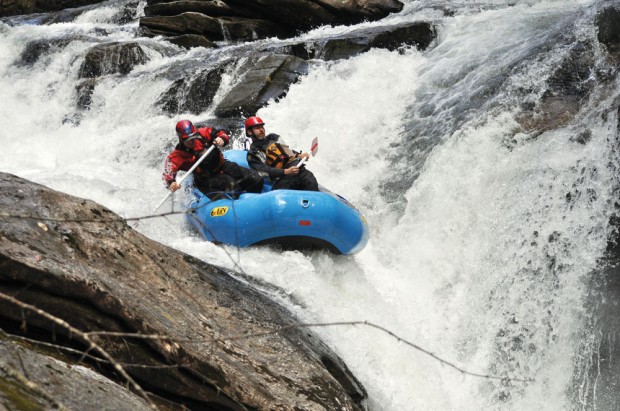Linc Stallings running Class IV+ dueling waterfalls. See the full gallery. Photo: Jeremy Rogers
“I’ve got a 50/50 success rate with that drop. About half the time, I swim,” Linc Stallings tells me after he negotiates our boat over a 10-foot waterfall into a deep pool flanked by massive boulders. We’re running the North Fork of the French Broad, a small stream that drops off the Blue Ridge Parkway in Western North Carolina. It’s a rain-dependent creek with class IV+ vertical drops, deep pools, and technical boulder gardens scattered throughout a two-mile stretch that’s popular with creek boaters. We’re running it in a small two-person raft called an R-2. Across the Southern Appalachians, a handful of boaters are beginning to take these small, 10-foot rafts down narrow, class IV-V creeks that have previously only been run in kayaks and the occasional canoe. It’s a niche sport that even some creek boaters think is a little crazy.
“People freak out when they see rubber coming down a creek,” Stallings says. “There are only a few people who would take a raft down these narrow rivers, so people still think it’s wild.”
Of those few R-2 boaters, Linc Stallings is easily one of the most experienced. The 36 year old has been guiding rafts down class V rivers for 15 years, working the biggest rivers in the South and Colorado depending on the year. He’s a rare breed: a professional raft guide, someone who’s committed to this as a career, not just something to do between college and “the real world.”
“I always thought I’d do it and move on. But I just kept doing it,” Stallings says. “I love it. I love taking people out on the river. I love hanging out with other boaters. I love the water.”
R-2 creeking is essentially what raft guides do on their day off. They borrow a small two-person raft from their bosses and push it, scrape it, and paddle like hell through tight rain-dependent creeks in the mountains. The North Fork of the French Broad is one of Stallings’ favorites. He first learned to creek boat here while attending Brevard College’s wilderness immersion program. He knows the nuances of every significant rapid the way a tween girl knows the lyrics to a Justin Bieber song.
“A ton of people have run this creek in a kayak,” he tells me as we begin to paddle toward the first class III rapid, just 50 yards from the put-in. “But running it in a raft has a completely different dynamic. Running tight drops in this big boat is fun, but there are some logistical things you have to work out. It’s like doing a math problem.”








